The world is divided into two types of sailors: Those who have no qualms scrambling up the ratlines to replace a bad anchor light, and the acrophobic among us who hoist an all-around white LED in the rigging and call it fixed.
Updating a topic that was last fully examined in 1993, Practical Sailor recently took a look at nine different bosun chairs and bosun chair alternatives to determine which ones are worth recommending to the sailor facing a repair project high above the deck and which ones wed drop into the nearest dumpster. Although our comparison doesn’t encompass every chair on the market, it includes most of the major players and presents a telling cross-section of the three major design types: climbing harness, the conventional open “swing” seat, and solid-back “diaper” type.
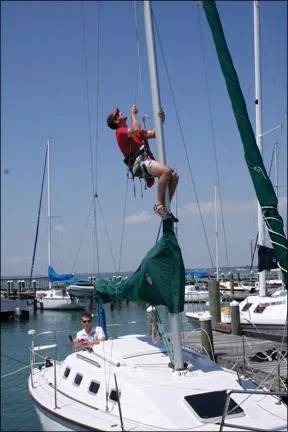
Included in this test were products from ATN, a small but well-established company that launched in 1985; Brion Toss, a renowned rigger based in Washington; Black Diamond, an outdoors sports company that caters to skiers and climbers; Harken, the well-known maker of sailing hardware and apparel; Plastimo, a French maker of a wide range of yacht equipment; and Spinlock, a British company that specializes in deck hardware and personal safety gear.
How We Tested
The first step of the evaluation was to compare construction quality, materials, and methods. For this, we enlisted the help of the experts at Knighton Sails, a sailmaking and rigging service in Sarasota, Fla., owned by Sarasota sailor Gregg Knighton. Based on the stitching and material inspections by the staff at Knighton, we ranked chairs according to overall construction quality. For field testing, a tester sat in each chair for 15 minutes while aloft and simulating a common repair task using a screwdriver and drill. Finalists were also field tested aboard the 28-foot Precision, Just Karma, which conveniently needed a new windvane at the mast top. The ratings in the table on page 11 reflect the combined results of all tests.
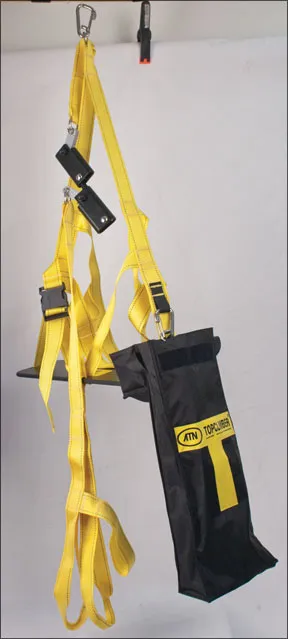
The column labeled “Comfort” on the table is key because it includes not only the cushiness factor, but the feeling of security it gave testers as they watched the world below grow smaller. If a bosuns chair is well designed, with good straps and support, it should be impossible or nearly so to slip, tip, or fall out. It should allow you to be hoisted as near as possible to the top of the mast. A provision for a downhaul, which can be secured by an assistant below to prevent the chair from swinging, or to run up spare parts, is also desirable. Hunting for tools, parts, nuts, and bolts can be tricky aloft, so the tool pockets (if any) and their placement were closely scrutinized.
While testing the chairs, it became clear that some tend to chafe, bind, and pinch in various tender places. We were glad to see that all the makers had placed the halyard well below eye level so it did not interfere with our work, a problem noted in previous tests.
It is important to keep in mind that even the best chair wont eliminate the risks of going aloft. Before making any decision regarding which product is best for you, we encourage you to read the tips on selecting and using a bosuns chair on page 12. And before you use your chair, be sure to read the makers instructions for proper care and use.
ATN Topclimber
An innovative adaptation of recreational climbing gear, the ATN Topclimber stood out in our comparison of unassisted climbing devices in the Aug. 15, 2005 issue. The Topclimber incorporates two familiar tools used by big-wall climbers-ascenders and aiders (web ladder)-and modifies them for use in climbing a mast. The device is familiar to attendees at major U.S. boat shows, where, like a tightrope walker, Topclimber demonstrators usually attract a curious crowd.
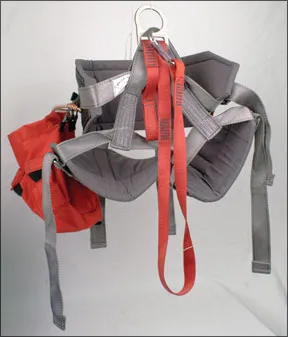
The Topclimber is unique from the other devices testers reviewed in that it is designed to climb a static pre-stretched half-inch line run from the top of the mast to the deck. The line, which must be purchased separately, adds about $150 to the total price, making the ATN the second most expensive product in our test.
The system uses two parts, each with its own ascender: One supports the durable fiber-reinforced plastic seat; the other supports a pair of webbed stirrups for the feet. Under load, the ascenders grip the line just like a rope clutch. To go up, you put your weight on one ascender while sliding the other one up a few feet, alternating as you climb. The stand-sit process of climbing is less strenuous than it looks, though it requires a fair degree of fitness, flexibility, and coordination. A video on the Topclimber website shows a good demonstration of the process. Because it permits solo ascents and still allows a rigid perch for the derriere, many riggers like this device. Unfortunately, to reach the top of the mast, you may have to “stand” on the foot webbing, a potentially precarious situation.
Using heavy-duty 1-inch webbing and plenty of reinforced stitching, the Topclimber is ruggedly constructed and has the basic features required for working aloft. The crotchstrap, front belt and buckle, and webbed back support offer a better feeling of security than any of the tested chairs.
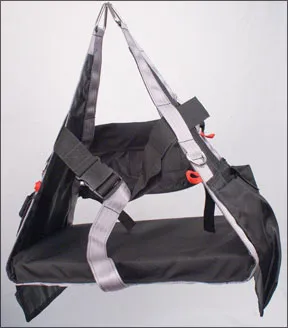
The package includes a stowage bag with a snap shackle so that it can be hooked to the Topclimber and serve as a toolbag while aloft. Laminated instructions fit into a clear sleeve on the side of the bag. One webbed loop on each side of the bosun chair will serve as an attachment point for the toolbag, tool lanyards, or a clip to accommodate a gantline for shuttling tools aloft. A 316-grade stainless-steel clip on webbing at the seats bottom keeps the chair close to the ascending line.
An experienced climber could combine conventional climbing ascenders, an aider (web ladder), and a climbing harness to build his own Topclimber at significant savings, but we would not recommend this for novices. (For the truly adventurous, a Prusik knot-or some variation-can be used in place of ascenders.) Anyone pondering the use of mountain climbing gear will want to watch for corrosion of non-marine grade hardware.
Testers noted that the Topclimber took longer to fit and rig than the other chairs in this group. A newer design, which Practical Sailor plans to test and report on as soon as it becomes available, features a different type of ascender that can be clamped to the static rope, no threading required. This should expedite rigging significantly. The ascenders may also be bought separately.
Bottom line: Earning a Practical Sailor Recommended rating, this ruggedly constructed chair/ascender is the only one in the comparison that is set up for going aloft alone. Drawbacks are the high price and the long distance between the halyard shackle and chair.
Brion Toss Bosun Harness
When youre a master rigger who has spent a good share of your working life above the spreaders, you have plenty of time to think about what youd like in your perfect bosun chair. Brion Toss is a rigger based in Port Townsend, Wash., who has built a loyal following among sailors through his seminars, instructional videos, and unique rigging tools. He has been involved in some of the most challenging rigging projects on the water, as well as on land, such as earthquake-proofing the 7-ton chandelier in Washington States capitol dome. The author of The Complete Riggers Apprentice, he is probably the most familiar name in rigging among recreational sailors.

Toss makes two bosun harnesses, the regular bosun harness and the cruisers. Both meet Occupational Safety and Health Administration (OSHA) standards and are based on a rescue harness designed by Ken Koerwitz. (The basic design is similar to the CMC Rescue Harness from California Mountain Company, which Toss recommends in his video, and sells for just $150, less than half the price of the Toss harnesses.)
Tosss cruisers harness uses all stainless-steel hardware, while the regular harness uses a high-grade cast alloy. In either case, youre getting the mother of all bosun harnesses. It has more extras than the average sailor needs, but the added features-such as multiple loops for tools and lanyard and redundant safety measures-reflect the insight of a conscientious and experienced rigger. These and other details will undoubtedly be appreciated over the life of the harness and during big projects.
Like the ATN, the Toss harnesses convert a climbing product-the rescue harness, in this case-for sailors. Because it is a harness, not a chair, it can be worn standing on deck or on mast-climbing steps. A properly adjusted climbing harness wont allow the wearer to slip out, even when he is inverted. Finally, a harness brings the wearers hips right up to the top sheave, whereas a bosuns chair typically stops several inches lower.
Climbing harnesses need to be worn snug, and the webbing and hardware tend to pinch. The “twig and berries” (a euphemism offered by one male tester) are particularly vulnerable for male users. The Toss harness, with its wide belt and oversized thigh supports, distributes body weight better than conventional climbing harnesses and, when snugged tight, was only slightly less comfortable than the testers favorite chair. Although it took some time to master the buckle adjustments, once the harness was fitted, testers felt far more secure in the Toss harness than they did in any of the conventional chairs.
Feature-wise, the Toss harness is king of the crows nest. It has a built-in tether with a locking carabiner to go around the mast to prevent swinging. The tether can also be used to temporarily attach to a fixed point aloft so that a halyard can be sent down for tools, etc. A spare carabiner is provided for self belay. The harness has three completely independent halyard attachment points; no other product in our test had more than one. There are also two loops for hanging extra gear, and a large multi-pocket pouch-Tosss riggers tool pouch-for cotter pins, small tools, tape, and other items. The chair also comes with Tosss informative DVD, “Going Aloft.”
The harness is available in two sizes, for adults with 24- to 30-inch waists, and those with 28- to 42-inch waists. Because it is a true climbing harness, an experienced climber could combine it with a static line, ascenders, and aiders to use it like the Topclimber, but it works just fine as a conventional halyard-supported chair.
Bottom line: The Practical SailorBest Choice. A well-engineered design, a variety of useful extras, and rugged construction put Tosss bosun harnesses in a class all their own. If you are cruising full time and don’t have a dry place to keep your harness, then it would be worth paying extra for the cruising harness and the stainless hardware. Otherwise, the original version should provide years of trouble-free service.
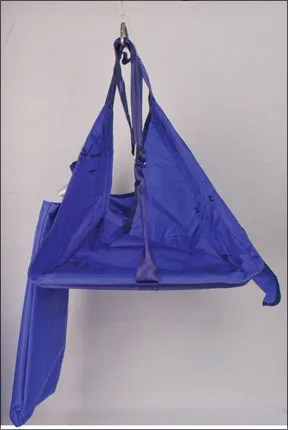
Harken Bosun Chair
For many years now, Harken has been quietly expanding its reach outside of the arena of sailboat hardware that originally built its brand. The Harken apparel division, in particular, has been churning out some fairly good products at competitive prices. One of the latest products to enter Harkens broad lineup, the bosun chair incorporates high-quality fabric and hardware, useful extras such as lanyard loops and tool pockets, and safety measures like a crotchstrap and backrest. The 12-inch by 18-inch seat was the biggest of the ones we looked at, possibly because this U.S-made product is targeted sharply at the land of big bottoms.
Though not nearly as rugged as the Toss harness, Harkens construction and features were a cut above all of the other chairs in our comparison. Two U.S.-made stainless-steel triangles attach to the halyard. Four stainless-steel D-rings and four loops for securing tool lanyards are on the outside of the chair. A D-ring at the bottom of the chair can be used for a downhaul or gantline. Two high-strength, polyester, seat-belt-type webbing straps provide the main support. One is doubled around the halyard shackles and doubled beneath the front of the chair; the other is doubled through the halyard shackles and around the back of the chair. An adjustable backrest, crotchstrap, and an adjustable front belt with a buckle provide added security. Deep pockets with Velcro closures on either side of the chair are big enough to accommodate a 3/8-drive cordless drill-driver.
The wide, well-padded seat was the most comfortable of the bunch, but a large, rigid seat might pose a problem aloft as one tries to work between the rigging and the mast itself. Putting all your weight on the forward edge of a wide chair could cause it to tip, but we found the Harken chair to be stable. In our view, the lack of maneuverability is a fair trade-off for the added comfort.
This chair was one of the easiest to hop into and start working, but the large plastic clip-buckle that made it easy to get into did not inspire as much confidence as the heavy-duty slide buckles used in the Toss harness. Testers noted that the user could not remove the plywood stiffener on the Harken chair to inspect it, or to replace the foam without cutting the fabric.
Bottom line: If you like the idea of a conventional bosuns chair thats easy to use at a moments notice, the Harken is a very good choice. It is our Recommended choice for a conventional bosuns chair.
Black Diamond Bosun Chair
Designed for big wall climbers who spend extended periods on hanging belays, the Black Diamonds bosuns chair was a fish out of water in our comparison. It lacked the extra attachment points for tools or gantlines, and it provided only a narrow backrest. It didnt have a triangle or D-ring for the halyard, only two stitched loops. There was no crotch strap.
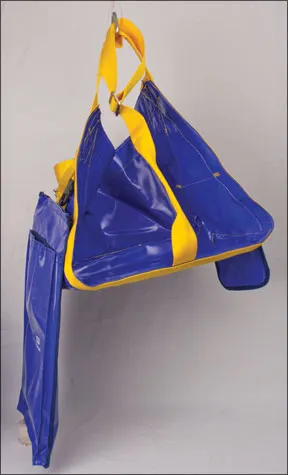
To be fair, the Black Diamond chair was designed as a place to plant your butt during prolonged hanging belays, not as a safety harness. Any climber seated in the chair would also be wearing a climbing harness on belay, and hed count on the harness, not the chair, to check his fall. For this reason and others, we would not recommend using this chair by itself. Experienced climbers could use it in conjunction with climbing gear or an independently belayed harness.
Testers found the well-padded seat to be very comfortable, and the chairs light weight and compact size would benefit small boaters. Its seven-ply marine grade plywood seat was easily removed for inspection. The independently adjustable sidestraps let the user raise or lower the chair relative to its hoisting point, helpful for getting high on the mast.
Bottom line: An experienced climber who relies on a harness system for going aloft could add this affordable chair to his arsenal for use during long projects, but it should not be regarded as a stand-alone bosuns chair.
Plastimo
Plastimo, a French company that has its products distributed in the U.S. by Navimo USA, produces three different bosuns chair, the Standard, Comfort model, and Pro models. The Standard is a very basic bosuns chair made of two-ply polyester with a stiffener at the bottom, webbing supports, and a stainless-steel halyard triangle. Although it had a crotchstrap, front strap, and an adjustable back strap, the minimum girth adjustment was about 60 inches, allowing plenty of room for a body to slip through. Wed not use this without a separate harness and belay. Although it had tool pockets on the side, they werent easily accessible aloft. Webbing was already beginning to fray at the halyard shackle on our test unit.
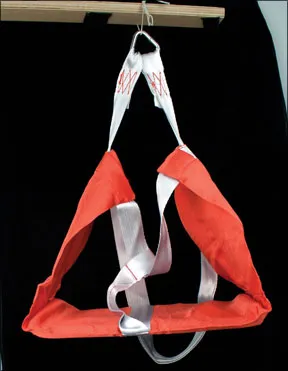
Plastimos Comfort and Pro models are what we call “diaper” chairs. They have crotchstraps and solid backs and, when fitted properly, have the appearance of a giant diaper-in this case a giant blue diaper. The differences between the two models are in the materials and construction. Both come with a deep, dual-purpose stowage/toolbag similar to that used by the Topclimber, and both have side pockets for tools. The Comfort uses coated polyester fabric, while the Pro model is coated PVC. Both have half-inch ply seats, but the Pro has heavier-duty 2-inch wide webbing with more reinforced stitching. Although elastic loops in the tool pouch could be used for tool lanyards, there are no additional D-rings or loops like those found in the Harken chair. None of the Plastimo chairs are padded.
The slide buckle that adjusts the strap on the Comfort model slipped during testing, so wed suggest finding the adjustment that fits and then stitching this strap in place. Of all the Plastimo chairs, the Pro was the only model that the testers liked, but its price was more than the Harken, a much better product in our view.
Bottom line: If youre enamored with the diaper-style bosuns chair, see if you can find a Pro model on sale. We see no reason to opt for any of these chairs over the Harken.
Spinlock Mast Pro
Like the Brion Toss Cruising Bosuns Harness, the Spinlock Mast Pro is a marine version of a big wall climbing harness. The original version was developed with Petzl, maker of climbing harnesses and this latest generation retains many of the same features. Lean and light, the harness is popular among sailors who want to feel secure if forced to go aloft at sea. We did not test any dedicated climbing harnesses, but several less-expensive harnesses from major climbing equipment companies like Petzl and Black Diamond closely resemble the Spinlock harness.
The Mast Pro harness is one size fits all, but the minimum waist adjustment on the one we tested was about 28 inches. It can be used in conjunction with Spinlocks Deckvest inflatable PFD. According to Spinlock, attaching the halyard to both the Deckvest and the Mast Pro offers additional back support, although this was not tested.
Comprised of two neoprene padded leg loops attached to a padded waist band, the harness is easier to adjust than the Toss harness, but not as comfortable, as the thigh supports are significantly smaller. Two elastic bands help adjust the distance between the thigh straps and the waistbelt. There are two small loops for hanging bags/gear, one velcro strap for securing a bulky tool, and three elastic straps for bags, extra line, or shackles. A pocket in the waistband is designed to take Spinlocks plastic tripping spike, for releasing spinnaker snap shackles.
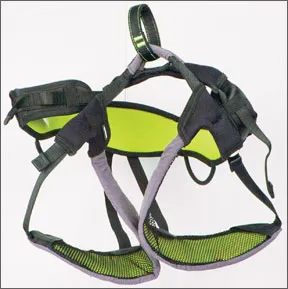
Though not ideal for long belays, this harness is more comfortable than it looks. It would be a good choice as a primary safety check for those going aloft in a basic bosuns chair. Though not as rugged or as comfortable as the Toss harness, it could be used alone as a bosuns chair and is less expensive
Bottom line: Compact and well constructed, this harness could satisfy cruisers offshore needs well. It is less comfortable than a chair, but it offers security that a chair cannot.
Conclusion
None of the mast-climbing devices in our test could be considered “comfortable” in the easy-chair sense of the word. Working aloft typically involves some awkward positions, and in all of these chairs, we were using our abdominal muscles (or whats left of them) to carry out tasks aloft. None of the back supports were as high as we would have liked, although the Toss harnesses were the best in that department. At the end of our study, it became very clear which ones the testers felt the safest in, as well as which were the most comfortable after 15 minutes aloft.
For the sailor who wont settle for anything but the best, the Toss harnesses scored nearly perfect 10s for comfort and security.
Another top vote-getter was the ATN Topclimber. The Topclimber makes going aloft alone possible, but it also requires more agility than some of the conventional bosuns chairs or harnesses. Gaining extra inches at the top of the mast also required a bit more gymnastics than did either harness.
The Harken bosuns chair would be our first pick for someone who puts comfort as the highest priority. Testers felt very secure in this seat, and the additional padding was appreciated. Multiple attachment points and deep pockets are a plus.
Finally, for the sailor looking for something more affordable than the Toss harness for emergency trips to the mast while at sea, the Spinlock harness fits the bill.
Plastimos Pro has some potential, but it doesn’t compete with the Harken, at about the same price. We hope that Plastimo goes back to the design board and addresses some of the issues we found in its other chairs.






































I have a Harken Busun’s Chair as shown in the photos above, however the photos do not have captions that indicate which chair is being described. The Harken Chair is shown within the text area of the ATN Mast Climber.
One issue I have with the Harken chair is that it slides back each time I stand up (whether using Ascenders or Prusik Knot’s) The ATN chair has straps that secure the thighs to the seat, whereas the Harken does not. Each time I stand in a foot strap, the Harken seat slips back up my butt and when I then sit on the chair, I have to reach behind me and slip it forwards in order to sit on the seat comfortably.
Yes. What Paul said. Please label the pictures so we know which one is what. The “A Closer look” pdf only has 3 pictures from bad angles.
I can’t help but wonder if it wouldn’t just be easier to load the pdf to avoid the confusion.
I have a Tom Taylor chair and am not sure which category it fits into. Hopefully not the dumpster category.
Rick
I’m using an ATN since years on my Centurion 38′, and for my experience it works fine. I agree with the long time needed to install the system; in order to shorten the time, I first hoist the “standing /static line, then fit in the ATN topclimber from the bottom part, before finally fixing the static line to the deck. Cheers!